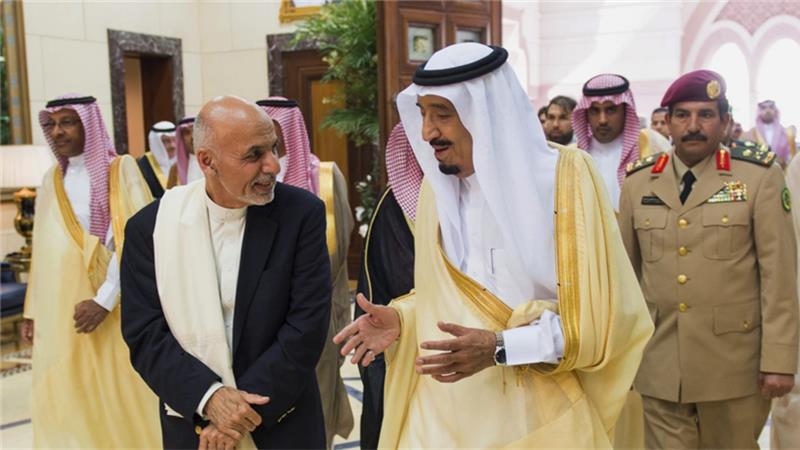How The Saudi-Iran Rivalry Is Playing Out In Afghanistan

NEW DELHI: In the last few months, Afghanistan has increasingly witnessed a new and dangerous development. Earlier this month on Ashura -- a commemoration of the martyrdom of Hussein, a grandson of the Prophet Muhammad -- blasts targeted the country’s Shia minority in the northern Balkh province and in the capital city of Kabul, killing dozens. The worst attack aimed at the Shias was in July this year, as 80 people were killed when a bomber targeted a protest march by members of the Shia Hazara minority.
Whilst Afghanistan has battled terrorism and militancy for decades, sectarian attacks have been relatively rare -- with attacks against minority groups, specifically Shias, being the hallmark of militancy in neighbouring Pakistan, and not Afghanistan historically.
Interestingly, most of the recent attacks targeting Shiites in Afghanistan have been claimed by the Islamic State -- which has a branch operating in parts of Afghanistan comprising largely of disgruntled Taliban fighters. Although the exact nature of the branch’s relationship to the parent group remains unknown, its operations in Afghanistan have become cause for international concern.
Whilst international media is preoccupied with the daily operations of the Islamic State in Afghanistan, what is being overlooked is how the growing influence of the Islamic State in the region has come to involve the Islamic world’s two largest powers -- Saudi Arabia and Iran.
In fact, the July bombing was purportedly in response to the recruitment of hundreds of Shia Hazaras by Iran to fight the terrorist group in Syria. “Unless they stop going to Syria and stop being slaves of Iran, we will definitely continue such attacks,” an ISIS commander was reported to have told Reuters.
In August, an Iranian official -- Qurban Ghalambor -- was arrested in Afghanistan for “recruiting Afghan Shiite fighters and sending them to Syria.” The official is a representative of Iran Supreme Leader Ali Khamenei’s office, with Afghan officials alleging that Iran has created a new brigade of Afghan and Pakistani fighters led by the Iranian Revolutionary Guard Corps to help the cause of Syrian President Bashar al Assad.
Iran’s efforts at recruiting Shias from Afghanistan have been documented by various groups. Human Rights Watch in late 2015 interviewed more than two dozen Afghans who had lived in Iran about recruitment by Iranian officials of Afghans to fight in Syria. Some said they or their relatives had been coerced to fight in Syria and either had later fled and reached Greece, or had been deported to Afghanistan for refusing. One 17-year-old said he had been forced to fight without being given the opportunity to refuse. Others said they had volunteered to fight in Syria in Iranian-organized militias, either out of religious conviction or to regularize their residence status in Iran.
“Iran has not just offered Afghan refugees and migrants incentives to fight in Syria, but several said they were threatened with deportation back to Afghanistan unless they did,” said Peter Bouckaert, emergencies director at Human Rights Watch. “Faced with this bleak choice, some of these Afghan men and boys fled Iran for Europe.”
Iran hosts an estimated 3 million Afghans, many of whom have fled persecution and repeated bouts of armed conflict in Afghanistan. Only 950,000 have formal legal status in Iran as refugees. The Iranian government has excluded the remainder from accessing asylum procedures, leaving many who may want to seek asylum undocumented or dependent on temporary visas.
Funerals for Afghan fighters killed in Syria are frequently held in Iran, sometimes attended by Iranian officials. While Iran officially claims that thousands of Afghans living in Iran have volunteered to join the militias, their vulnerable legal position in Iran and the fear of deportation may contribute to their decision, making it less than voluntary.
On the other hand, Saudi Arabia’s influence and intervention in the region runs even deeper. For one, Saudi Arabia and other gulf countries allegedly give support to Pakistani groups such as the Lashkar e Jhangvi (LeJ) -- a group that has carried out several attacks against Shias in Pakistan and is known to have links with the Islamic State. In fact, according to a leaked cable several years ago, US Secretary of State Hillary Clinton warned that Saudi Arabia were the "most significant source of funding to Sunni terrorist groups worldwide". She said it was "an ongoing challenge" to persuade Saudi officials to treat such activity as a strategic priority. The groups funded include al-Qaeda, the Taliban and Lashkar-e-Taiba, she added.
While there is no concrete and decisive proof that the Saudis fund terror groups, the general perception links Saudi Arabia to Sunni groups active in South Asia and West Asia, with the Taliban being one such group.
These dual developments -- of Tehran’s alleged efforts to recruit Shia fighters from South Asia, and Saudi Arabia’s reported financing of Sunni groups in the region -- are intensifying Saudi-Iran rivalry by turning Afghanistan into a Shia-Sunni battleground.
Additionally, both countries are revving up efforts to flex their soft power muscles in Afghanistan. This includes efforts to build and finance madrasas, mosques, religious centres, etc. Tehran, in fact, has built one of Afghanistan’s largest madrasas in Kabul, the Khatam-al Nabyeen Islamic University. Saudi Arabia, in turn, has built a $100 million mosque and Islamic Education Center in Kabul.
As a result of all of the above, Shia-Sunni loyalties in South Asia now resonate with developments far away in West Asia. For instance, Saudi Arabia’s execution of prominent Shia cleric Nimr al-Nimr in January -- following his conviction on terrorism charges -- sparked protests by Shia Muslims across the world, including in South Asia.
In Afghanistan, this resonation is particularly dangerous, as the Iran-Saudi rivalry comes to play out in typically sectarian tones by radicalising the local population. This is a new development for the violence torn country, as given all its problems historically, sectarian strife wasn’t one.



